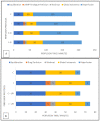Cardioprotection of Immature Heart by Simultaneous Activation of PKA and Epac: A Role for the Mitochondrial Permeability Transition Pore
- PMID: 35163640
- PMCID: PMC8836102
- DOI: 10.3390/ijms23031720
Cardioprotection of Immature Heart by Simultaneous Activation of PKA and Epac: A Role for the Mitochondrial Permeability Transition Pore
Abstract
Metabolic and ionic changes during ischaemia predispose the heart to the damaging effects of reperfusion. Such changes and the resulting injury differ between immature and adult hearts. Therefore, cardioprotective strategies for adults must be tested in immature hearts. We have recently shown that the simultaneous activation of protein kinase A (PKA) and exchange protein activated by cAMP (Epac) confers marked cardioprotection in adult hearts. The aim of this study is to investigate the efficacy of this intervention in immature hearts and determine whether the mitochondrial permeability transition pore (MPTP) is involved. Isolated perfused Langendorff hearts from both adult and immature rats were exposed to global ischaemia and reperfusion injury (I/R) following control perfusion or perfusion after an equilibration period with activators of PKA and/or Epac. Functional outcome and reperfusion injury were measured and in parallel, mitochondria were isolated following 5 min of reperfusion to determine whether cardioprotective interventions involved changes in MPTP opening behaviour. Perfusion for 5 min preceding ischaemia of injury-matched adult and immature hearts with 5 µM 8-Br (8-Br-cAMP-AM), an activator of both PKA and Epac, led to significant reduction in post-reperfusion CK release and infarct size. Perfusion with this agent also led to a reduction in MPTP opening propensity in both adult and immature hearts. These data show that immature hearts are innately more resistant to I/R injury than adults, and that this is due to a reduced tendency of MPTP opening following reperfusion. Furthermore, simultaneous stimulation of PKA and Epac causes cardioprotection, which is additive to the innate resistance.
Keywords: development; immature heart; ischaemia/reperfusion injury; mitochondria.
Conflict of interest statement
The authors declare no conflict of interest. The funders had no role in the design of the study; in the collection, analyses, or interpretation of data; in the writing of the manuscript, or in the decision to publish the results.
Figures






Similar articles
-
Functional and cardioprotective effects of simultaneous and individual activation of protein kinase A and Epac.Br J Pharmacol. 2017 Mar;174(6):438-453. doi: 10.1111/bph.13709. Epub 2017 Feb 14. Br J Pharmacol. 2017. PMID: 28071786 Free PMC article.
-
Preconditioning or Postconditioning with 8-Br-cAMP-AM Protects the Heart against Regional Ischemia and Reperfusion: A Role for Mitochondrial Permeability Transition.Cells. 2021 May 17;10(5):1223. doi: 10.3390/cells10051223. Cells. 2021. PMID: 34067674 Free PMC article.
-
Consecutive pharmacological activation of PKA and PKC mimics the potent cardioprotection of temperature preconditioning.Cardiovasc Res. 2010 Nov 1;88(2):324-33. doi: 10.1093/cvr/cvq190. Epub 2010 Jun 16. Cardiovasc Res. 2010. PMID: 20558443 Free PMC article.
-
The role of mitochondria in protection of the heart by preconditioning.Biochim Biophys Acta. 2007 Aug;1767(8):1007-31. doi: 10.1016/j.bbabio.2007.05.008. Epub 2007 Jun 2. Biochim Biophys Acta. 2007. PMID: 17631856 Free PMC article. Review.
-
The cardioprotective actions of statins in targeting mitochondrial dysfunction associated with myocardial ischaemia-reperfusion injury.Pharmacol Res. 2022 Jan;175:105986. doi: 10.1016/j.phrs.2021.105986. Epub 2021 Nov 17. Pharmacol Res. 2022. PMID: 34800627 Review.
Cited by
-
Assessing Drug-Induced Mitochondrial Toxicity in Cardiomyocytes: Implications for Preclinical Cardiac Safety Evaluation.Pharmaceutics. 2022 Jun 21;14(7):1313. doi: 10.3390/pharmaceutics14071313. Pharmaceutics. 2022. PMID: 35890211 Free PMC article. Review.
-
Protecting the Mitochondria in Cardiac Disease.Int J Mol Sci. 2022 Jul 23;23(15):8115. doi: 10.3390/ijms23158115. Int J Mol Sci. 2022. PMID: 35897690 Free PMC article.
-
Pyruvate Upregulates Hepatic FGF21 Expression by Activating PDE and Inhibiting cAMP-Epac-CREB Signaling Pathway.Int J Mol Sci. 2022 May 14;23(10):5490. doi: 10.3390/ijms23105490. Int J Mol Sci. 2022. PMID: 35628302 Free PMC article.
References
MeSH terms
Substances
Grants and funding
LinkOut - more resources
Full Text Sources
Research Materials

